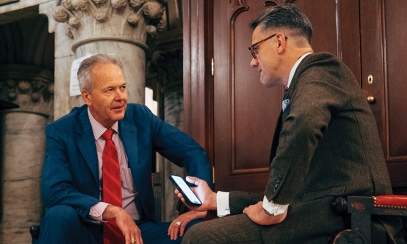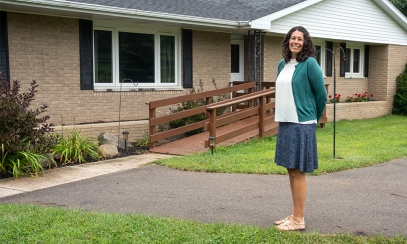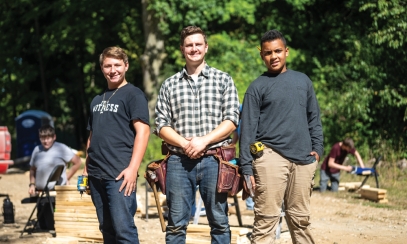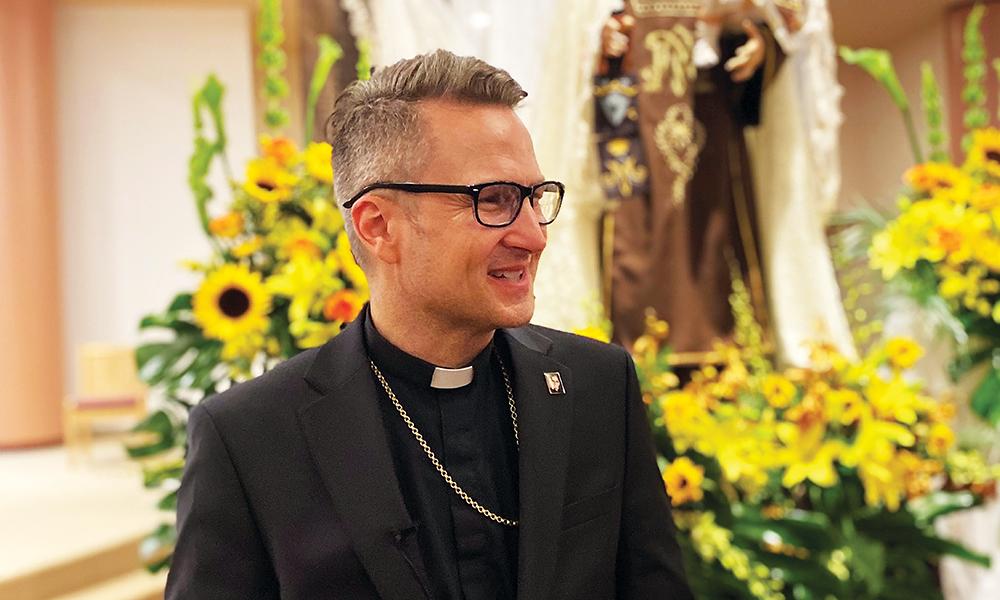
Bishop Ronald A. Hicks Named as Sixth Bishop of the Diocese
When Bishop Ron Hicks was ready to share his amazing news with his parents, he drove to their home in Tinley Park.
With his parents and him wearing masks, sitting in his parents’ garage at a safe distance away from them, he said, “I have some news for you. Your son is soon going to be appointed the bishop of his own diocese. Would you like to guess where?”
His father commenced to guess. He guessed Denver. Then Cincinnati. Then Columbus, Ohio. And he kept going — naming places in California and Texas.
“He was going all around the country, just shooting out these possibilities," Bishop Hicks said. “My mom was sitting there with a blank look on her face. I said no. I’m going to be your neighbor, right over the border. I’m going to Joliet. My mom, without missing a beat, just shouted out, ‘Oh, praise God!’ They're happy that I'm close. I'm happy to be here.”
Bishop Hicks, who turned 53 on Aug. 4, will be leaving his current position as vicar general at the Archdiocese of Chicago to be installed as the next bishop of the diocese at the Cathedral of St. Raymond Nonnatus in Joliet on Sept. 29, the feast of the Archangels.
The previous bishop of the diocese was Bishop R. Daniel Conlon, who, last December, asked Pope Francis for a medical leave of absence, which was granted. Then, several months ago, in early May, Bishop Conlon resigned, citing that, at the age of 71, he was no longer able “to carry the burden of leadership” of a diocese with around 616,000 Catholics.
Since December, the diocese has been led by Bishop Richard E. Pates. Once the installation occurs, Bishop Pates, the former bishop for the Diocese of Des Moines, will go back to retirement, which is what he was enjoying when he was called into service to become the diocese’s apostolic administrator.
"The Diocese of Joliet is most grateful to Pope Francis for the appointment of Bishop Ronald Hicks as its sixth bishop,” said Bishop Pates. The bishop owns a reputation for pastoral leadership and is totally committed to the ongoing renewal of the Catholic Church. He is a worthy successor to Bishop Conlon and his predecessors."
Bishop Hicks, a native of Harvey, IL, grew up in South Holland, IL, where he attended St. Jude the Apostle Parish and Grade School. He remembers the vibrant parish and school with fondness, full of gratitude for the wonderful nuns, teachers, lay people and “extraordinary priests.”
When he was in the sixth grade, one of the priests invited him and several other students to attend a high school, Quigley South, seminary summer program. Although he wasn’t thinking of priesthood at the time, he liked the school, and, with the encouragement of the priest, he attended it, graduating in 1985.
“Quigley was outstanding,” he said. “It was the seed that was planted that said maybe I should keep on thinking about the priesthood.”
He took the next step on that path by attending Niles College of Loyola University Chicago, where he graduated in 1989, getting a B.A. in philosophy.
When he graduated, at the age of 21, he felt sure that God was calling him to the priesthood in the Archdiocese of Chicago. He also felt that there needed to be more Spanish-speaking priests, so the rector of the seminary recommended a mission in Mexico, called Nuestros Pequeños Hermanos (NPH), which is Spanish for “Our Little Brothers and Sisters.” NPH is a home dedicated to caring for more than 3,400 orphaned and abandoned children in nine Latin American and Caribbean countries.
The priest recommended he spend a year there and paid for his airfare and for two weeks of language school to learn a little bit of Spanish before he arrived. The experience at the NPH impacted him tremendously.
“Learning Spanish has been a beautiful gift that has opened up not only the culture, but the ministry and all the people,” he said.
Not only did he learn to be fluent in the language, but, after witnessing all the unconditional love that occurred at the home, he felt convinced that the Lord was calling him to the priesthood.
His next degrees — a Master of Divinity degree in 1994 and a Doctor of Ministry degree in 2003 — were both from the University of St. Mary of the Lake in Mundelein, IL.
One of his classmates at Mundelein — they both started there in 1990 — was Father David Boettner, who is now the vicar general for the Diocese of Knoxville. They lived on the same floor, shared similar tastes in music, participated in the same formation group at the seminary and became great friends.
“As a seminarian and as a priest, he has always had a deep love of people and a generosity of his time to serve the needs of others,” Father Boettner said. “I am not surprised at all that God has called Bishop Hicks to be a bishop. He has always lived his promise of obedience to the Church, and his first answer when asked to serve is almost always yes. … I know that he will be a gift to the Church of Joliet.”
After his ordination, Bishop Hicks served as an associate pastor at Our Lady of Mercy Parish in Chicago from 1994 to 1996 and then at St. Elizabeth Seton Parish in Orland Hills, IL, from 1996 to 1999.
One of his former parishioners, Catherine Velcich, has known him for 22 years. He was a priest at her parish, St. Elizabeth Seton, in Orland Hills.
“One could write a book on the personal characteristics that make Bishop Hicks a good priest,” she said. “Bishop Hicks is pastoral, he is missionary and has a special place in his heart for the poor and the marginalized. He is authentic, humble, approachable, loving and caring. He teaches without admonishing and leads without minimizing others.”
She continued, “One way you know a person is genuine is by watching others and how they relate to a person. Bishop Hicks is still considered a parish favorite at St. Elizabeth Seton. He relates to all ages, and when he comes back to visit, people line up to greet him — from the babies he baptized and formed in the faith two decades ago to our mature parishioners who started the parish 33 years ago.
One gift that several of his friends affirmed he has is his gift of preaching.
“I still remember homilies from Father Hicks that are over 20 years old,” Velcich said. “One homily that comes to mind immediately was on God and neighbor; it still resonates with me and is relevant now more than ever. Bishop Hicks is filled with the Holy Spirit and shares that gift generously with those around him.”
Years later, Velcich crossed paths with him in his vicar general role at the archdiocese. She was part of an affiliated advisory board.
“I was thrilled to see he hadn't changed,” she said. “The characteristics that make him a great priest also make him a great leader. He relates to all of God's people, and because of this, people want to work with him.”
From 1999 to 2005, Bishop Hicks lived and ministered at St. Joseph College Seminary as the dean of formation.
In July 2005, with permission from Cardinal Francis George, Bishop Hicks moved from Chicago to El Salvador to begin a five-year term as regional director of NPH in Central America.
“I enjoyed every minute,” Bishop Hicks said. “It was a direct experience with the poor, with kids whose lives were changed for the better because of a collaboration with good people and following a solid mission. I’ve left part of my heart there still.”
From 2010 to 2014, Bishop Hicks served as the dean of formation at Mundelein Seminary. During that time, he also assisted with weekend Masses at St. Jerome Parish in Rogers Park in Chicago.
A seminarian at the time that Father Hicks was at Mundelein was Mark Bernhard, who is now a priest in the Diocese of Joliet.
“My most vivid memory of Father Hicks came on the evening we honored him before he left for his new assignment as vicar general,” said Father Bernhard, a parochial vicar at St. Mary’s Church in Mokena. “At the end of the evening, Father Hicks had an opportunity to address all the seminarians with some last words. He made it a point to tell all of us how much he ‘loved being a priest.’ I always saw him as a man who loved Jesus and desired to make disciples.”
Bishop Hicks was appointed vicar general of the archdiocese by Cardinal Blase J. Cupich on Jan. 1, 2015. On Sept. 17, 2018, he was ordained an auxiliary bishop at Holy Name Cathedral in Chicago.
Someone who has worked with Bishop Hicks at St. Joseph College Seminary and Mundelein Seminary, is Father James Presta, the pastor at St. Emily Church in Mount Prospect, IL, in the Archdiocese of Chicago. Father Presta said the seminarians viewed the bishop as someone who had great listening skills, was fair and had a genuine desire to help others in need.
“He has been a close friend and a confidant to me,” said Father Presta. “He is an outstanding priest who ministers with a compassionate and loving heart. He is a true leader, a shepherd of souls. He has been a mentor to young priests. He offers them fraternal support and sound, practical wisdom as a brother priest. … He has the great respect and admiration of Cardinal Cupich, our Chicago bishops and his brother priests in the archdiocese. Chicago’s loss is Joliet’s gain. He personally knows many of the priests in the Joliet Diocese. Bishop Hicks will be an excellent shepherd and leader of the priests and lay faithful of the Diocese of Joliet.”
When Bishop Hicks got the call from the apostolic nuncio, Archbishop Christophe Pierre, it was early in the morning, and he had just finished praying. He was about to stand up when the phone rang. He noticed it was from nuncio, who is Pope Francis’ representative to the U.S. bishops. He thought the call had to do with an appointment, or perhaps the archbishop had a question. The thought that raced through his mind, he said, was “to be open.”
After greeting him, Archbishop Pierre said, “Congratulations, the Holy Father has appointed you as the sixth bishop of Joliet.”
Bishop Hicks replied, “I accept, and please share my gratitude with the Holy Father.”
They chatted for a few more minutes, and after the call ended, Bishop Hicks said he felt peace in his mind and heart.
“One of the things I've learned along the way is to look for ways of saying ‘yes,’ saying ‘yes’ to the Lord,” Bishop Hicks said. “One of the images I use is if we are asked to do something for God or the Church it just may be the Holy Spirit whispering in our ears. We should try if we can to look for the ways to say yes instead of ‘no.’ So, I said, ‘yes.’ Since then, people have already have asked me, ‘Well, did you stop sleeping after that?’
“No, I haven't. I have a heart full of trust and peace. I've come to believe that God has a plan. Things are not coincidence. There is providential love, and oftentimes we're not aware of it. I’ve learned to come to trust in God's goodness and providence for us.”
As Bishop Hicks looks forward to being installed as the next bishop of the diocese, he is certain that, in collaboration with others and with God’s grace, he is going to spread the Good News.
“I love Jesus,” he said. “As a baptized Catholic, I want to continue to evangelize and to make sure that the faith is growing. It's not only growing for a certain segment, but for everyone — for young people, for the elderly, for those of us who may be the middle. Jesus should be the center of our lives, and I'm very excited about looking for ways to bring Christ and God to the center.”
Bishop Ronald A. Hicks’ Coat of Arms
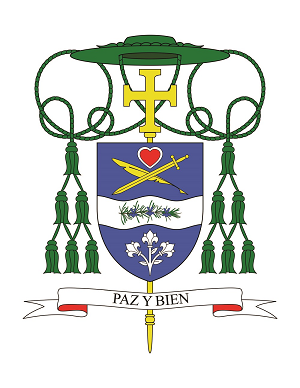
The Coat of Arms reflects Bishop Ronald Hicks’ life and spiritual journey. It was designed by Deacon Paul J. Sullivan.
At the top of the Coat of Arms, there is a red heart, which highlights the bishop’s love of his missionary service at NPH (Nuestros Pequeños Hermanos) and the “heartfelt people” in the parishes of the Archdiocese of Chicago who have continually taught him that “love grows here.”
According to NPH’s website (https://www.nph.org/), the seed of NPH was planted in 1954, “when a boy was arrested for stealing from the poor box of a small church in Cuernavaca, Morelos, Mexico. The young priest in charge there, Father William Wasson of the United States, was unwilling to press charges against this ‘thief.’ Instead, he asked for custody of the boy. One week later, the judge sent him eight more homeless boys. By year’s end, 32 boys were in residence and Nuestros Pequeños Hermanos, Spanish for ‘Our Little Brothers and Sisters,’ was born.
“Over 19,200 children have grown up in the NPH family, which now operates homes in eight additional countries: Honduras, Haiti, Nicaragua, Guatemala, El Salvador, the Dominican Republic, Peru and Bolivia. Today, over 3,400 children are being cared for in a loving, secure environment.”
Continuing with the description of Bishop Hicks’ Coat of Arms, next is a quill and sword to honor Saint Paul. Bishop Hicks is grateful to have grown up in an ecumenical family which inspired him to preach and share the Word of God with all people.
The center is composed of a white wavy bar with the bright blue background. It is indicative of water, symbolizing the Sacrament of Baptism and also Lake Michigan to recognize where Bishop Hicks grew up in South Holland, IL, and Chicago’s 18 miles of shoreline.
In the middle of the wavy bar is a sprig of rosemary. The Spanish word for “rosemary” is “romero.” It pays homage to the martyred Archbishop of El Salvador, Saint Oscar Romero, and to the extraordinary people of Central America with whom Bishop Hicks lived and worked for five years.
At the base, there is a three-blossom sprig of lilies that is taken from the arms of “The University of Saint Mary of the Lake” in Mundelein, where Bishop Hicks attended the seminary, earned his Doctorate in Ministry and served on the faculty. It expresses his profound respect for all who serve on faculty and staff and for the seminarians who continue to respond YES to the Lord’s call.
For his motto, His Excellency, Bishop Hicks, has adopted the motto in Spanish “PAZ Y BIEN.” This phrase, attributed to Saint Francis of Assisi, emphasizes the true PEACE which comes from Christ and ALL THE GOOD He shares through His Word and Sacrament.
The Crest is completed with the external ornaments, including a yellow processional cross, which extends above and below the shield, and a pontifical hat, called a galero, with its six tassels, in three rows, on either side of the shield, all in green. These are the heraldic insignia of a prelate of the rank of bishop by instruction of the Holy See.

